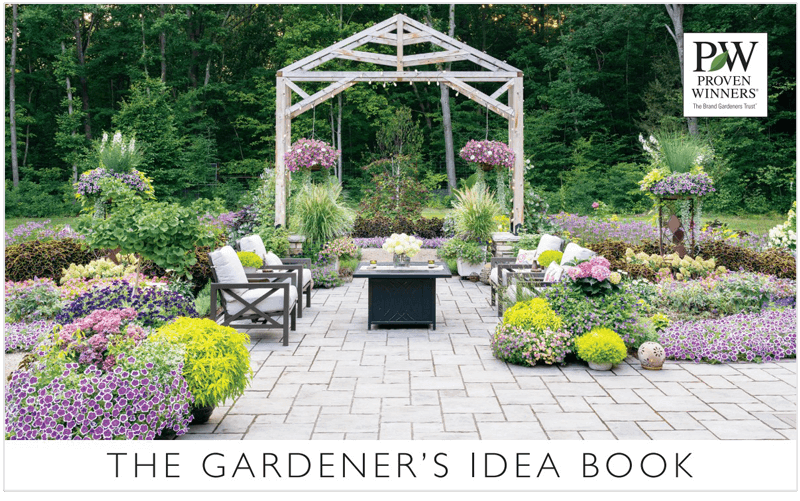Dahlia - The Ultimate Growing Guide from Proven Winners®
Add long-lasting color to the landscape with these dazzling flowering plants
 Buy dahlias - Order plants online and have them shipped right to your door
Buy dahlias - Order plants online and have them shipped right to your door
Dahlia flowers capture the spirit of the high garden season, delivering an exuberant display of color from mid-summer into fall. With striking blooms in a wide range of colors, sizes, and forms these late-season stars shine when many other plants have faded.
There are two main types of dahlias: pot dahlias and tuber dahlias. Proven Winners® primarily offers pot dahlias. Pot dahlias are naturally compact, well-branched, and free-flowering, making them ideal for containers and garden beds. Tuber dahlias are taller, with long stems and can be overwintered in frost-free zones or stored indoors in colder climates.
Native to the temperate mountains of Mexico, dahlias thrive in mild temperatures between 50 and 80 degrees Fahrenheit. Whether you choose compact pot varieties or larger tuber types, you’ll enjoy season-long color with the right care. Read on for tips on how to grow dahlias, care advice, and top varieties to try.
GROWING AND CARING FOR DAHLIAS
How to plant: Plant pot dahlias in full sun to part sun after the danger of frost has passed. Space plants 12 to 18 inches apart, depending on the variety, to allow for good air circulation. They are ideal for containers, borders, and combination plantings.
Soil: Grow in well-drained, fertile soil enriched with compost or other organic matter. Pot dahlias prefer soil that stays evenly moist but not soggy. For containers, use a high-quality potting mix.
Watering: Water regularly to keep the soil consistently moist, especially during hot, dry periods. Container-grown plants may need more frequent watering. Irrigate around the base of plants rather than overhead to discourage powdery mildew on the foliage.
Pruning: Pot dahlias are naturally well-branched and do not require pinching to promote fullness. Deadhead spent blooms to keep plants looking fresh and to encourage continuous flowering from planting until frost.
Fertilizing: Use a low-nitrogen formula such as a bloom booster with roughly a 1-2-2 NPK (nitrogen-potassium-phosphorus) ratio. Apply fertilizer 30 days after planting and repeat monthly throughout the growing season. Containers will need more frequent fertilizing, as nutrients leach out more quickly. Fertilize container plants every 2 to 3 weeks.
TRY THESE PROVEN WINNERS® VARIETIES
Add some of these dazzling pot dahlia varieties to your yard:
 | Virtuoso® Dayglo Yellow™ (Dahlia variabilis) has an exceptionally long bloom time, with vigorous green foliage and large, double, bright yellow flowers. Plants are mildew resistant and versatile in containers, beds and borders. The sturdy stems hold up well in cut flower arrangements.
|
 | Virtuoso® Pinkerific™ (Dahlia variabilis) produces large, double, soft pink flowers from summer into fall. Pollinators are attracted to the long-lasting blooms. Use in a butterfly garden, mixed border or containers.
|
 | Virtuoso® Rad Raz® (Dahlia variabilis) has double deep pink blooms, dark green foliage, and a vigorous growth habit. This eye-catching variety is useful as a focal point, in a cutting garden, or combined in containers with other annuals.
|
 | Virtuoso® Classy Carmine™ (Dahlia variabilis) has exceptional garden performance, producing dense foliage and bright carmine-red double flowers that bloom throughout summer and into fall. Use as a focal point and in cut flower arrangements.
|
 | Virtuoso® Vibrant Violet™ (Dahlia variabilis) is a stunning variety with rich violet-purple flowers that add long-lasting color to the landscape. Combine with complementary-colored yellow or orange flowers for stunning contrast. Use as a thriller element in containers, as an elegant focal point, or in cut flower arrangements.
|
 | Mystic Illusion (Dahlia hybrid) has deep purple-black foliage and single lemon-yellow star-shaped flowers with a dark center. The striking contrast can be seen even from a distance. This award-winning dahlia variety is mildew resistant, with a versatile growth habit suitable for borders or containers.
|
 | Dalina® Grande Cancun (Dahlia hybrid) produces masses of burgundy-red flowers with distinctive white tips, creating a striking two-tone effect from spring until the first frost. The lush green foliage and upright habit make it an excellent choice for adding drama to containers, garden beds, or borders. Ideal as a cut flower, it performs best in full sun to part sun and benefits from regular deadheading to maintain continuous blooms. Zones: 9-11
|
TUBER DAHLIA TIPS
Unlike pot dahlias, which are grown from rooted cuttings, tuber dahlias start from underground storage roots planted in spring. They are often taller, with longer stems suited for planting in rows, and may require staking for support.
Planting: Set tubers in the ground after the danger of frost has passed. Space according to variety, giving tall types room to grow.
Care: Pinching young plants encourages bushier growth. Deadhead regularly to extend the bloom season.
Overwintering: In frost-free zones, tubers can stay in the ground year-round. In colder regions, dig them up after frost blackens the foliage, store in a cool, dry place, and replant the following spring.
|
HOW TO USE DAHLIAS IN YOUR LANDSCAPE
Dahlias add long-lasting color to beds, borders and containers. Here are some ideas on how to use dahlias in your yard:
- Plant dahlias in a cottage-style border in combination with classic cottage garden plants for an exuberant, informal look.
- Devote an entire bed to a dahlia garden, including varieties with different forms and colors.
- Fill gaps in a mixed border with dahlias for quick color. Tuber varieties can reach up to 5 feet tall can be planted towards the back, while shorter pot types can be planted in front.
- Place a pot dahlia plant in a decorative container by itself as a captivating focal point, or in combination with other plants to add bright color to a sunny deck or patio.
- Mass dahlias in a bed by themselves, or in combination with other warm-season annuals such as canna lily, elephant ears, coleus and lantana for bright color all summer long.
- Plant a fall border with dahlias and other late-season bloomers such as asters, Joe pye weed, ornamental grasses, goldenrod and black-eyed Susan.
- Include dahlias in a cutting garden alongside other plants such as gladiolus, Shasta daisy, sunflower, zinnias and cosmos for colorful bouquets to display in your home.
- Plant tuber dahlias in a row along a fence or property line as a colorful hedge.
- Use a pot variety to edge a border or pathway.
DAHLIA FAQs
What’s the difference between pot and tuber dahlias?
Pot dahlias, like the Proven Winners® Virtuoso® and Mystic series, are grown from rooted cuttings rather than tubers. They are naturally compact, well-branched, and free-flowering, making them ideal for containers, garden beds, and combination plantings. Pot dahlias do not form storage tubers and are typically grown as annuals.
Tuber dahlias start from underground storage roots planted in spring. They can grow much taller—up to 5 feet or more—and often have long stems suited for professional floral arrangements. In colder climates, tubers can be dug up in fall and stored indoors to replant the following year.
Are dahlias perennials? Do they come back every year?
Tuber dahlias can survive from year to year with proper care. Since plants are frost sensitive, the green growth will die back after the first hard frost. In Zone 7 or colder, dahlia tubers will not survive in the ground over the winter. Pot dahlias, which do not form storage tubers, are grown as annuals and replaced each season.
When to plant dahlias?
Dahlias need warm temperatures in order to grow. Plant tubers in mid-to-late spring after all danger of frost has passed and the soil temperature has reached 60 degrees Fahrenheit. Planting sooner, when the soil is still cold and wet, can result in tuber rot and failure to thrive. Pot dahlias grown in nursery containers can be planted once frost danger has passed.
Do deer eat dahlias?
Dahlias are not a preferred food source of deer, though plants may incur damage from grazing if other food sources are scarce. Learn more about choosing deer-resistant plants.
Do dahlias like sun or shade?
Dahlias perform best with at least 6 hours of full sun per day. In hotter climates, provide some afternoon shade.
Do you cut off dead dahlia blooms?
Removing spent dahlia flowers will encourage new growth and flower buds, resulting in more flowers and a longer bloom time. New flower buds and spent blooms can look similar, so take care not to remove the buds. Spent flowers will have a cone shape, while buds are more rounded. Cut flowers that are finished blooming back to the first set of leaves for a neater appearance.
Do dahlias do better in pots or ground?
Growing dahlias in pots is a good solution if you have limited space, poorly draining soil, or want to display them on a patio or deck. Choose small- to medium-sized pot dahlia varieties and provide a 12-to-16-inch container large enough to accommodate the roots. Make sure there are adequate drainage holes in the bottom of the pot. Dahlias in containers will need more frequent watering and fertilizing than those in the ground.
COMPANION PLANTS
Combine dahlias alongside other plants with similar cultural needs of full sun, well-drained soil and moderate water.
Create a colorful cottage-style garden with dahlias and other flowering plants such as:
- Meteor Shower® verbena
- ‘Firefly Peach Sky’ yarrow
- ‘Treasure Trove’ black-eyed Susan
- Upscale® ‘Pink Chenille’ bee balm
Combine compact Virtuoso® dahlia varieties in containers alongside:
- Luscious® Berry Blend™ lantana
- Illusion® Emerald Lace sweet potato vine
- Whirlwind® Blue fan flower
- Supertunia® Hoopla® Vivid Orchid™
For long-lasting summer color, plant a sizzling sunny border with dahlias and other plants such as:
- Toucan® Coral canna lily
- Rainbow Rhythm® ‘Storm Shelter’ daylily
- Color Coded® Knock 'em Red coneflower
- Meant to Bee® ‘Royal Raspberry’ anise hyssop
Buy Proven Winners plants:





